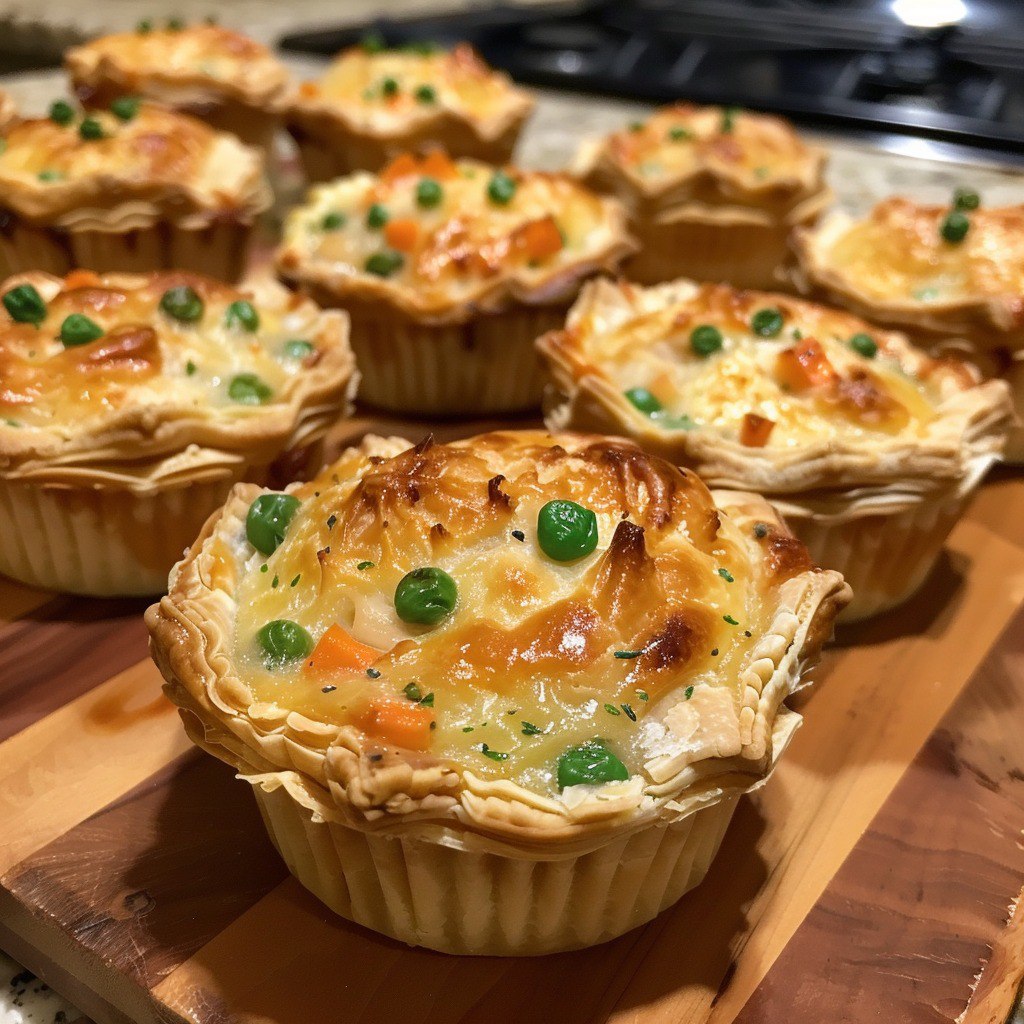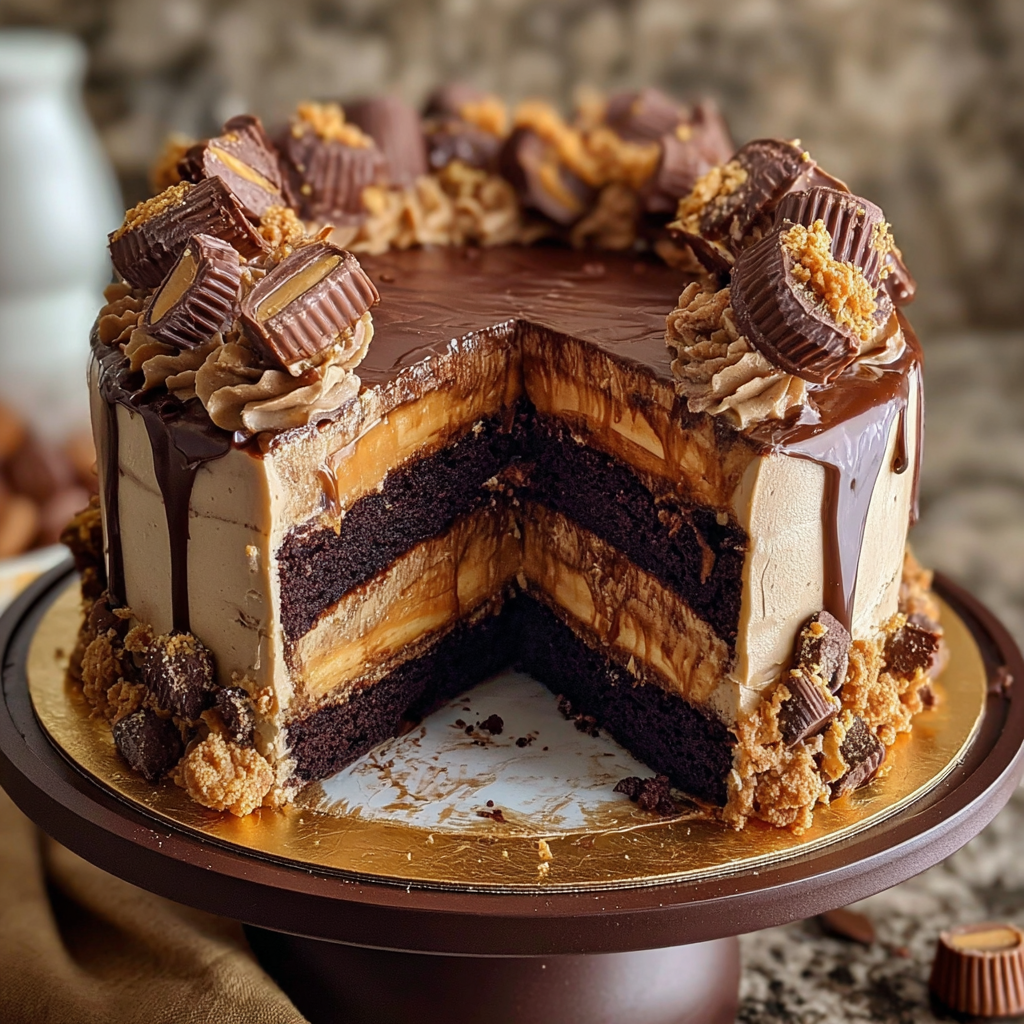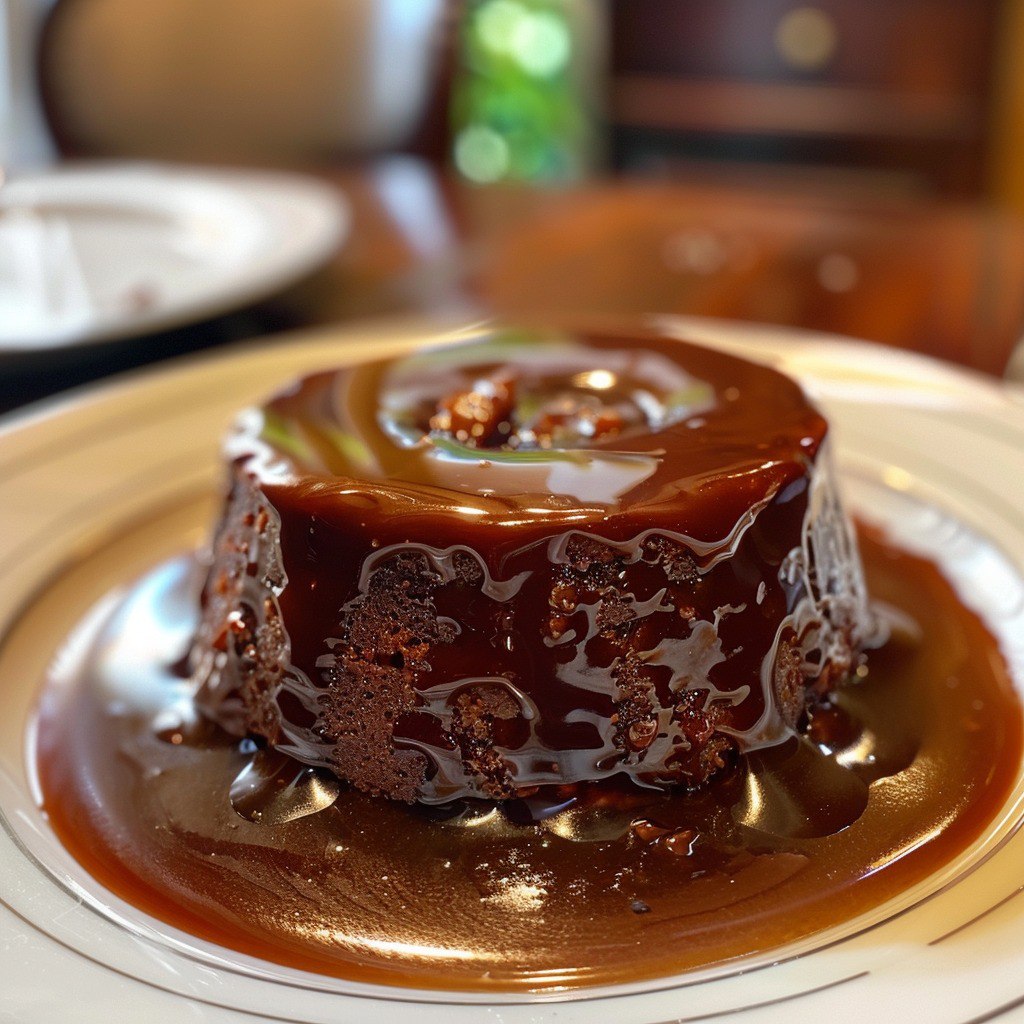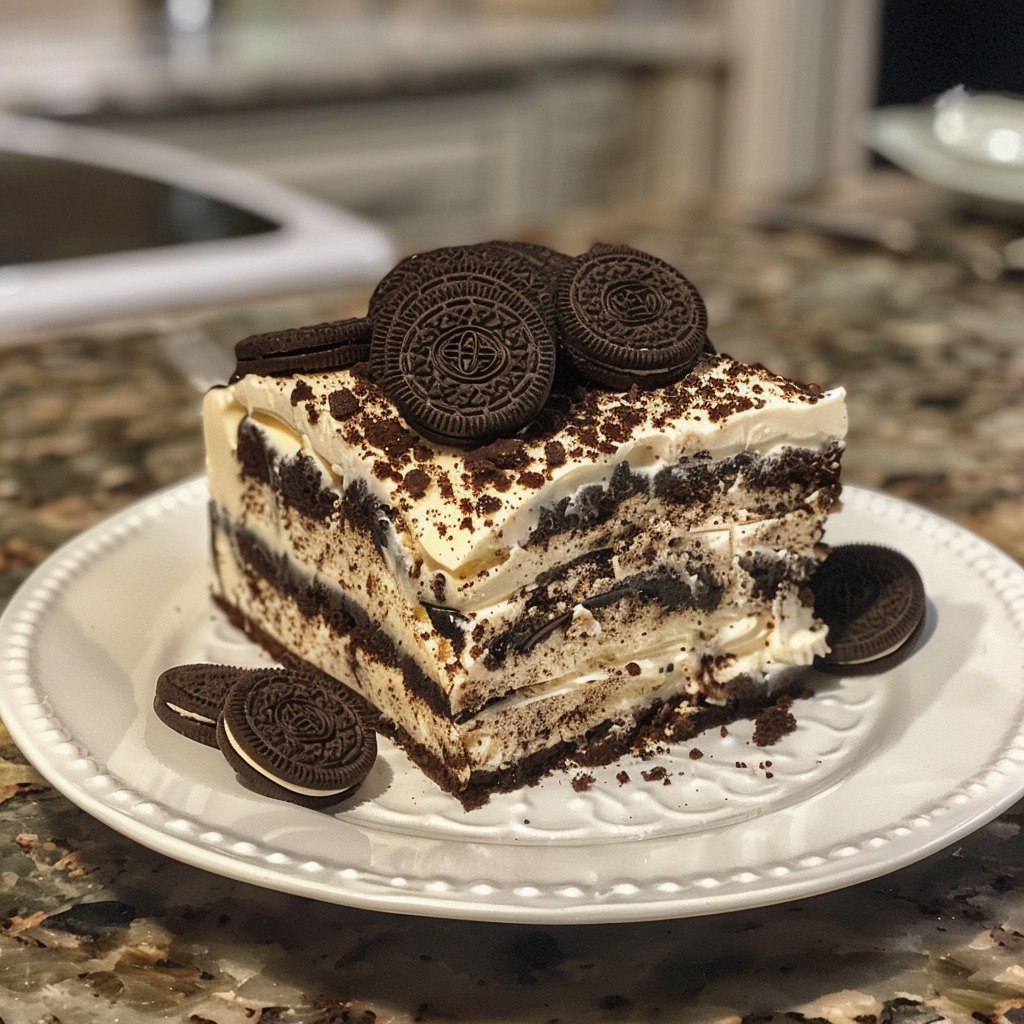Are you craving the ultimate comfort food that combines rich, savory flavors with heartwarming satisfaction? Moreover, imagine the classic French onion soup transformed into a substantial, filling meal. The French Onion Beef and Noodles recipe delivers exactly this culinary magic, bringing together tender beef, caramelized onions, and melted cheese over hearty egg noodles.
Furthermore, this dish represents the perfect fusion of French culinary tradition with American comfort food sensibilities. Additionally, it’s designed to warm you from the inside out on chilly evenings. Whether you’re feeding a hungry family or entertaining guests, this recipe guarantees satisfaction and requests for seconds.
Print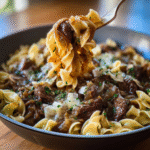
French Onion Beef and Noodles: Ultimate Comfort Food Recipe
- Total Time: 2 hrs
- Yield: 4 servings 1x
Description
French Onion Beef and Noodles is a comforting, hearty dish that brings together tender beef, deeply caramelized onions, and rich broth over buttery egg noodles, finished with melted Gruyere or Swiss cheese for an irresistible twist on classic French onion soup.
Ingredients
- 1 lb beef stew meat, cubed
- Salt and pepper, to taste
- 2 tbsp olive oil
- 3 large onions, thinly sliced
- 3 cloves garlic, minced
- 4 cups beef broth
- 1 cup dry red wine (optional)
- 1 tbsp Worcestershire sauce
- 1 tsp dried thyme
- 8 oz wide egg noodles
- 1 cup shredded Gruyere or Swiss cheese
- Fresh thyme or parsley for garnish
Instructions
- Season beef with salt and pepper.
- Heat olive oil in a large pot or Dutch oven over medium-high heat. Add beef and brown on all sides. Remove and set aside.
- Add sliced onions to the same pot and cook over medium heat, stirring occasionally, until caramelized and golden, about 20–25 minutes.
- Stir in minced garlic and cook for 1–2 minutes until fragrant.
- Return beef to the pot. Add beef broth, red wine (if using), Worcestershire sauce, and dried thyme. Bring to a boil.
- Reduce heat to low, cover, and simmer for 1–1.5 hours until beef is tender.
- Meanwhile, cook egg noodles according to package instructions. Drain and set aside.
- Preheat the broiler.
- Ladle beef and onion mixture over cooked noodles in bowls. Top each serving with shredded cheese.
- Place under broiler for 1–2 minutes until cheese is melted and bubbly.
- Garnish with fresh thyme or parsley and serve warm.
Notes
- For deeper flavor, use homemade beef stock instead of store-bought broth.
- Swap red wine for extra broth if you prefer to cook without alcohol.
- Great served with crusty bread or a side salad.
- Prep Time: 30 mins
- Cook Time: 1.5 hrs
- Category: Main Dish
- Method: Stovetop & Broiler
- Cuisine: Comfort Food / French-Inspired
Nutrition
- Serving Size: 1 bowl
- Calories: 450 kcal
- Sugar: 6 g
- Sodium: 800 mg
- Fat: 18 g
- Saturated Fat: 8 g
- Unsaturated Fat: 8 g
- Trans Fat: 0 g
- Carbohydrates: 38 g
- Fiber: 3 g
- Protein: 32 g
- Cholesterol: 100 mg
Keywords: French onion beef, beef and noodles recipe, comfort food, caramelized onions, cheesy beef noodles
Why You’ll Love This French Onion Beef and Noodles
This French Onion Beef and Noodles dish offers numerous compelling reasons to become a household favorite. Moreover, it combines convenience with gourmet flavors in one satisfying meal.
Key Benefits:
• One-Pot Wonder: Minimal cleanup with maximum flavor development • Budget-Friendly: Uses affordable cuts of beef that become tender through slow cooking • Crowd-Pleasing: Appeals to both adults and children with familiar flavors • Make-Ahead Friendly: Flavors improve when prepared in advance • Customizable: Easily adaptable to dietary preferences and restrictions • Comfort Food Classic: Provides emotional satisfaction and warmth • Impressive Presentation: Looks restaurant-quality with melted cheese topping
Additionally, this recipe transforms humble ingredients into something extraordinary. Furthermore, the slow-cooking process develops deep, complex flavors that rival expensive restaurant dishes. Moreover, the combination of textures creates a satisfying eating experience.
Essential Ingredients for Your French Onion Beef and Noodles
Creating the perfect French Onion Beef and Noodles requires carefully selected ingredients that build layers of flavor. Moreover, each component contributes to the dish’s signature taste profile.
Main Ingredients:
• 1 lb beef stew meat, cubed – Choose well-marbled cuts for maximum tenderness • 3 large onions, thinly sliced – Yellow onions provide the best caramelization • 8 oz wide egg noodles – Sturdy pasta that holds up to the rich sauce • 4 cups beef broth – High-quality broth forms the flavor foundation • 1 cup shredded Gruyere or Swiss cheese – Creates the signature melted topping
Flavor Enhancers:
• 2 tbsp olive oil – For browning and sautéing • 3 cloves garlic, minced – Adds aromatic depth • 1 cup dry red wine (optional) – Enhances richness and complexity • 1 tbsp Worcestershire sauce – Provides umami depth • 1 tsp dried thyme – Classic herb pairing with beef and onions • Salt and pepper – Essential seasoning foundation
Furthermore, ingredient quality significantly impacts the final result. Moreover, using fresh herbs when possible elevates the dish. Additionally, choosing aged cheeses creates more complex flavors in the finished dish.
Step-by-Step Guide to Making Perfect French Onion Beef and Noodles
Creating this French Onion Beef and Noodles masterpiece requires patience and proper technique. Moreover, following these detailed steps ensures restaurant-quality results every time.
Step 1: Preparing the Beef
Begin by cutting beef stew meat into uniform cubes if not already done. Additionally, pat the meat dry with paper towels to ensure proper browning. Furthermore, season generously with salt and pepper on all sides.
Moreover, allowing the meat to come to room temperature for 15-20 minutes improves cooking evenness. Additionally, well-seasoned meat develops better flavor during the browning process. Furthermore, uniform pieces ensure consistent cooking throughout.
Step 2: Browning the Beef
Heat olive oil in a large pot or Dutch oven over medium-high heat. Moreover, add beef cubes in a single layer, avoiding overcrowding. Additionally, brown on all sides for 2-3 minutes per side until deeply caramelized.
Furthermore, proper browning creates the foundation for rich flavor development. Moreover, don’t move the meat too soon – let it develop a golden crust. Additionally, work in batches if necessary to avoid steaming the meat.
Step 3: Caramelizing the Onions
In the same pot with the remaining oil and beef drippings, add thinly sliced onions. Moreover, cook over medium heat, stirring occasionally, for 20-25 minutes until golden brown and caramelized. Additionally, this step requires patience for proper flavor development.
Furthermore, properly caramelized onions develop sweet, complex flavors that define the dish. Moreover, avoid rushing this process with high heat, which burns rather than caramelizes. Additionally, the onions should be deeply golden and soft when finished.
Step 4: Building the Flavor Base
Add minced garlic to the caramelized onions and cook for 1-2 minutes until fragrant. Moreover, be careful not to burn the garlic, which creates bitter flavors. Additionally, return the browned beef to the pot.
Furthermore, pour in beef broth, red wine (if using), Worcestershire sauce, and dried thyme. Moreover, scrape up any browned bits from the bottom of the pot. Additionally, bring the mixture to a boil before reducing heat.
Step 5: Slow Cooking Process
Reduce heat to low, cover, and simmer for 1-1.5 hours until beef is fork-tender. Moreover, check occasionally and add more broth if needed. Additionally, the liquid should just cover the meat and onions.
Furthermore, low, slow cooking breaks down tough connective tissues in the beef. Moreover, the meat should easily shred with a fork when properly cooked. Additionally, taste and adjust seasoning during the final 30 minutes.
Step 6: Preparing the Noodles
Cook egg noodles according to package instructions until al dente. Moreover, drain well and set aside. Additionally, slightly undercook the noodles since they’ll continue cooking when combined with the hot beef mixture.
Furthermore, reserve some pasta cooking water in case the final dish needs moisture. Moreover, toss the drained noodles with a small amount of olive oil to prevent sticking. Additionally, time the noodle cooking to finish just before serving.
Tips for Making the Best French Onion Beef and Noodles
Mastering this French Onion Beef and Noodles recipe requires understanding key techniques and avoiding common mistakes. Moreover, these expert tips ensure consistently excellent results.
Beef Selection and Preparation:
• Choose chuck roast or stew meat for best flavor and tenderness • Cut against the grain if using roast meat • Don’t skip the browning step – it creates essential flavor • Pat meat dry before seasoning for better browning
Additionally, marbled cuts become more tender during slow cooking. Furthermore, uniform pieces ensure even cooking throughout. Moreover, proper seasoning penetrates better on dry surfaces.
Onion Caramelization Secrets:
• Use medium heat to prevent burning • Stir occasionally but don’t rush the process • Add salt to help draw out moisture • Be patient – proper caramelization takes time
Furthermore, deeply caramelized onions develop complex sweetness. Moreover, rushing this step results in bitter, burned flavors. Additionally, properly caramelized onions should be golden brown and jammy.
Liquid Management:
• Use quality beef broth for best flavor foundation • Don’t add too much liquid initially • Adjust during cooking as needed • Taste and season throughout the process
Moreover, the liquid should just cover the ingredients. Additionally, reduction concentrates flavors during cooking. Furthermore, proper seasoning balance develops over time.
Common Mistakes to Avoid When Preparing French Onion Beef and Noodles
Even experienced cooks can encounter challenges with this French Onion Beef and Noodles recipe. Moreover, understanding these pitfalls prevents disappointment and ensures success.
Inadequate Browning:
Many home cooks skip or rush the browning step, missing crucial flavor development. Moreover, proper browning creates the Maillard reaction that adds depth. Additionally, overcrowding the pan causes steaming instead of browning.
Furthermore, insufficient browning results in less flavorful final dish. Moreover, taking time for proper browning pays dividends in taste. Additionally, working in batches ensures each piece browns properly.
Rushing the Onion Caramelization:
Impatience during onion caramelization leads to burned, bitter flavors. Moreover, high heat causes burning rather than proper caramelization. Additionally, insufficient cooking time results in harsh, sharp onion flavors.
Furthermore, properly caramelized onions should be sweet and jammy. Moreover, this process cannot be rushed without sacrificing quality. Additionally, the investment in time creates the dish’s signature flavor.
Overcooking the Noodles:
Overcooked noodles become mushy and break apart in the final dish. Moreover, they continue cooking when combined with the hot beef mixture. Additionally, timing is crucial for proper texture.
Furthermore, al dente noodles maintain their shape and texture. Moreover, they should have slight bite when drained. Additionally, rinsing with cold water stops the cooking process if needed.
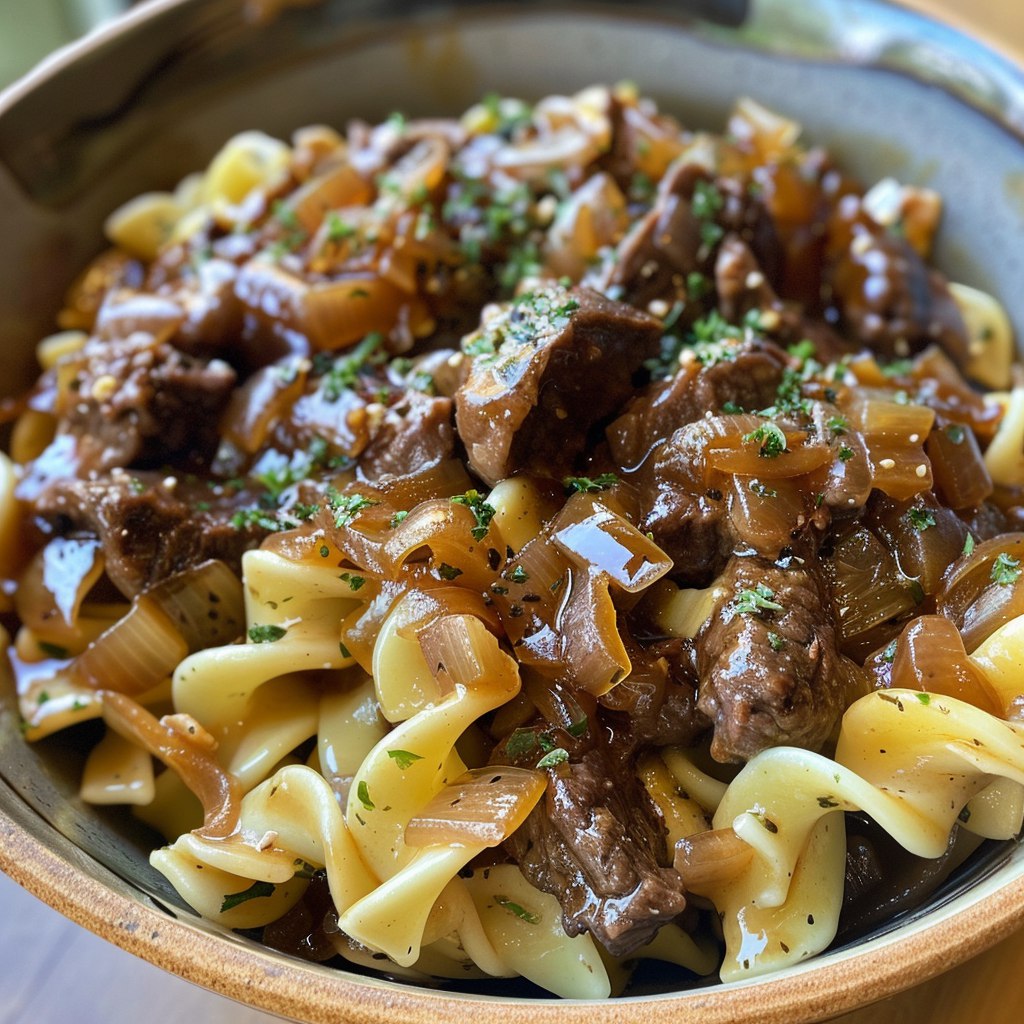
Nutritional Benefits of French Onion Beef and Noodles
Understanding the nutritional profile of French Onion Beef and Noodles helps with meal planning and dietary considerations. Moreover, this dish provides substantial nutrition along with comfort food satisfaction.
Protein Content:
Each serving provides approximately 25-30 grams of high-quality protein from the beef. Moreover, protein supports muscle maintenance and growth. Additionally, it promotes satiety and helps regulate blood sugar.
Furthermore, beef protein contains all essential amino acids. Moreover, it’s particularly rich in iron and B vitamins. Additionally, the slow cooking process doesn’t diminish the protein quality.
Carbohydrate Balance:
The egg noodles provide complex carbohydrates for sustained energy. Moreover, they offer a good source of B vitamins and iron. Additionally, the portion size provides balanced nutrition without excess.
Furthermore, complex carbohydrates provide steady energy release. Moreover, they support brain function and physical activity. Additionally, the fiber content aids digestion and satiety.
Calorie Considerations:
Each serving contains approximately 450 calories, making it a substantial main dish. Moreover, the calories come from balanced macronutrients. Additionally, the satisfying nature prevents overeating.
Furthermore, the calorie density provides good value for nutritional content. Moreover, the protein and fat content promote satiety. Additionally, portion control helps maintain caloric balance.
Creative Variations of French Onion Beef and Noodles
This versatile French Onion Beef and Noodles recipe accommodates numerous modifications and enhancements. Moreover, these variations cater to different tastes and dietary requirements.
Protein Alternatives:
• Chicken thighs create lighter version with similar cooking method • Pork shoulder offers rich flavor with different texture • Mushrooms provide vegetarian option with umami depth • Turkey creates leaner alternative with similar taste
Additionally, each protein requires slight timing adjustments. Moreover, chicken cooks faster than beef. Furthermore, vegetarian versions need flavor boosters like soy sauce or mushroom broth.
Cheese Variations:
• Provolone melts beautifully with mild flavor • Mozzarella provides stretchy texture and neutral taste • Fontina offers nutty, complex flavor • Cheddar creates sharper, more pronounced taste
Furthermore, combining different cheeses creates unique flavor profiles. Moreover, aged cheeses provide more complex tastes. Additionally, cheese quality significantly impacts the final result.
Vegetable Additions:
• Mushrooms add earthy depth and meaty texture • Carrots provide sweetness and color • Celery offers fresh crunch and flavor • Bell peppers create colorful, nutritious addition
Moreover, vegetables should be added at appropriate cooking stages. Additionally, harder vegetables need longer cooking times. Furthermore, delicate vegetables should be added near the end.
Wine Pairing Suggestions for French Onion Beef and Noodles
Selecting appropriate wines enhances the French Onion Beef and Noodles dining experience. Moreover, proper pairings complement the rich, savory flavors.
Red Wine Options:
• Cabernet Sauvignon provides full-bodied complement to beef • Merlot offers smooth, approachable pairing • Pinot Noir creates lighter alternative with fruit notes • Côtes du Rhône delivers French authenticity with spice
Additionally, medium to full-bodied reds work best with rich beef dishes. Moreover, tannins in red wine complement the protein. Furthermore, aged wines provide complexity that matches the dish.
White Wine Alternatives:
• Chardonnay offers buttery richness that complements cheese • Viognier provides aromatic complexity • White Burgundy creates elegant, food-friendly pairing • Gewürztraminer offers spicy notes that enhance flavors
Furthermore, full-bodied whites can pair surprisingly well. Moreover, oak-aged whites provide richness that matches the dish. Additionally, aromatic whites enhance the overall dining experience.
Make-Ahead Strategies for French Onion Beef and Noodles
Planning ahead makes French Onion Beef and Noodles accessible for busy schedules. Moreover, proper make-ahead techniques can actually improve flavors.
Advance Preparation:
• Brown beef up to 2 days ahead and refrigerate • Caramelize onions in advance and store separately • Prepare beef mixture completely and refrigerate • Cook noodles just before serving for best texture
Additionally, flavors develop and meld during refrigeration. Moreover, reheating gently prevents overcooking. Furthermore, separating components prevents texture issues.
Storage Guidelines:
• Refrigerate beef mixture for up to 3 days • Freeze portions for up to 3 months • Store noodles separately to prevent mushiness • Keep cheese fresh until ready to use
Furthermore, proper storage containers prevent flavor absorption. Moreover, labeling with dates ensures food safety. Additionally, freezing in portions allows convenient serving sizes.
Reheating Methods:
• Stovetop method provides best texture control • Oven method works well for large quantities • Microwave method offers quick individual portions • Slow cooker method keeps warm for serving
Moreover, gentle reheating prevents overcooking the beef. Additionally, adding fresh broth restores moisture if needed. Furthermore, melting cheese fresh creates better presentation.
Serving Suggestions and Presentation Tips
Proper presentation elevates French Onion Beef and Noodles from simple comfort food to restaurant-quality dish. Moreover, thoughtful serving enhances the dining experience.
Plating Techniques:
• Use individual oven-safe bowls for authentic presentation • Layer noodles first then top with beef mixture • Distribute cheese evenly for consistent melting • Broil until bubbly for golden, appetizing appearance
Additionally, warming the bowls prevents rapid cooling. Moreover, attractive presentation increases appetite appeal. Furthermore, individual portions allow customization.
Garnish Ideas:
• Fresh thyme sprigs add color and aroma • Chopped parsley provides fresh contrast • Caramelized onion strings enhance visual appeal • Crusty bread offers textural contrast
Furthermore, garnishes should complement rather than compete. Moreover, fresh herbs add brightness to rich dishes. Additionally, edible garnishes enhance both appearance and flavor.
Side Dish Recommendations:
• Crusty French bread perfect for soaking up sauce • Simple green salad provides fresh contrast • Roasted vegetables add color and nutrition • Pickled vegetables cut through richness
Moreover, sides should balance the rich main dish. Additionally, acidic elements cleanse the palate. Furthermore, textural variety enhances the meal experience.
Troubleshooting Common Issues with French Onion Beef and Noodles
Even experienced cooks encounter challenges with this French Onion Beef and Noodles recipe. Moreover, understanding solutions prevents frustration and ensures success.
Tough Beef Problems:
Tough beef usually indicates insufficient cooking time or temperature. Moreover, connective tissues need time to break down properly. Additionally, rushing the process results in chewy, unpleasant texture.
Furthermore, using the wrong cuts can create toughness issues. Moreover, lean cuts don’t have enough marbling for slow cooking. Additionally, proper temperature control ensures even cooking.
Bitter Onion Flavors:
Bitter onions result from too high heat during caramelization. Moreover, burned bits create unpleasant flavors throughout the dish. Additionally, insufficient cooking time leaves harsh, sharp flavors.
Furthermore, proper caramelization requires patience and medium heat. Moreover, stirring occasionally prevents burning. Additionally, adding a pinch of sugar can help caramelization.
Sauce Consistency Issues:
Watery sauce indicates too much liquid or insufficient reduction. Moreover, proper simmering concentrates flavors and thickens naturally. Additionally, removing the lid during final cooking helps reduce excess liquid.
Furthermore, thick sauce may need additional broth for proper consistency. Moreover, the sauce should coat the noodles without being gluey. Additionally, tasting and adjusting throughout cooking prevents problems.
Seasonal Adaptations for French Onion Beef and Noodles
This French Onion Beef and Noodles recipe adapts beautifully to seasonal ingredients and occasions. Moreover, these variations keep the dish fresh and interesting year-round.
Fall Variations:
• Add butternut squash for seasonal sweetness • Include fresh sage for autumn herb flavor • Use apple cider instead of wine for harvest taste • Add roasted root vegetables for hearty texture
Additionally, fall flavors complement the rich beef beautifully. Moreover, seasonal produce adds nutritional variety. Furthermore, warm spices enhance the comfort food appeal.
Winter Adaptations:
• Increase herb quantities for warming flavors • Add root vegetables for heartiness • Use darker, richer broths for depth • Include warming spices like bay leaves
Furthermore, winter versions can be heartier and more substantial. Moreover, longer cooking times work well with winter schedules. Additionally, rich flavors combat cold weather perfectly.
Spring Modifications:
• Add fresh herbs for brightness • Include spring onions for milder flavor • Use lighter broths for fresher taste • Add peas or asparagus for color and nutrition
Moreover, spring versions can be lighter and more refreshing. Additionally, fresh ingredients brighten the heavy winter dish. Furthermore, seasonal vegetables add color and nutrition.
FAQs About French Onion Beef and Noodles
Q: Can I use another type of cheese?
A: Absolutely! While Gruyere and Swiss are traditional, provolone, mozzarella, or even sharp cheddar work beautifully. Moreover, the key is choosing a cheese that melts well and complements the beef flavors. Additionally, mixing different cheeses creates unique flavor profiles.
Q: How do I prevent the noodles from becoming mushy?
A: Cook noodles just until al dente and drain well before combining with the beef mixture. Moreover, slightly undercook them since they continue cooking when mixed with the hot sauce. Additionally, avoid letting the finished dish sit too long before serving.
Q: Can I make this dish without wine?
A: Yes! Simply omit the wine and add an extra cup of beef broth instead. Moreover, the wine adds depth but isn’t essential for the recipe’s success. Additionally, you can substitute with additional Worcestershire sauce for complexity.
Q: How long should I caramelize the onions?
A: Proper caramelization takes 20-25 minutes over medium heat. Moreover, rushing this step with high heat results in burning rather than caramelization. Additionally, the onions should be golden brown and jammy when finished.
Q: Can I use a slow cooker for this recipe?
A: Yes! Brown the beef and caramelize onions first, then transfer to a slow cooker. Moreover, add liquids and seasonings, then cook on low for 6-8 hours. Additionally, cook noodles separately and combine just before serving.
Q: What’s the best way to reheat leftovers?
A: Reheat gently on the stovetop over low heat, adding broth if needed. Moreover, avoid microwaving if possible, as it can make the noodles mushy. Additionally, add fresh cheese and broil briefly to restore the melted topping.
Conclusion
The French Onion Beef and Noodles recipe represents the pinnacle of comfort food perfection, combining rich flavors with satisfying textures. Moreover, this dish transforms simple ingredients into a restaurant-quality meal that warms both body and soul. Additionally, the slow-cooking process develops deep, complex flavors that improve with time.
Furthermore, this recipe proves that gourmet dining doesn’t require complicated techniques or expensive ingredients. Moreover, the make-ahead friendly nature makes it perfect for busy families and entertaining. Additionally, the customizable elements allow for personal touches and dietary adaptations.
Whether you’re seeking comfort on a cold evening or impressive fare for guests, this recipe delivers consistently excellent results. Moreover, the combination of tender beef, caramelized onions, and melted cheese creates an unforgettable dining experience. Additionally, the hearty nature ensures satisfaction that lasts for hours.
Ready to create your own French Onion Beef and Noodles masterpiece? Try this recipe tonight and experience the perfect marriage of French sophistication and comfort food satisfaction. Moreover, share your cooking adventures and variations in the comments below. Additionally, don’t forget to rate this recipe and help others discover this incredible dish!

